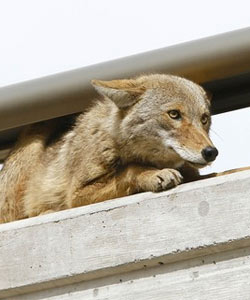 Another coyote was rescued in the city on Monday. Admittedly, the rescue wasn’t as amazing as the time a coyote wandered into a Loop Quizno’s sub shop in 2007, plopped itself into an open cooler next to bottles of fruit juices and soda, and waited for Animal Care and Control employees to whisk it away. Nor was it as heart-tugging as the icicle-covered coyote scooped off an ice floe by a Fire Department boat in December 2011. That coyote, named Holly, took several months to recuperate from frostbitten paws before she was released back into the wild.
Another coyote was rescued in the city on Monday. Admittedly, the rescue wasn’t as amazing as the time a coyote wandered into a Loop Quizno’s sub shop in 2007, plopped itself into an open cooler next to bottles of fruit juices and soda, and waited for Animal Care and Control employees to whisk it away. Nor was it as heart-tugging as the icicle-covered coyote scooped off an ice floe by a Fire Department boat in December 2011. That coyote, named Holly, took several months to recuperate from frostbitten paws before she was released back into the wild.
Still, this latest coyote—a female estimated to be approximately one year old—was hunkered down on the LaSalle overpass by Stockton Drive. News reports said she was rescued by ACC and would transfer to Flint Creek Wildlife Rehabilitation, which has locations near Barrington, Itasca, and Northerly Island in the city.
Related:
TOP 40 OMG MOMENTS IN RECENT CHICAGO HISTORY »
Coyote at Quiznos is number 33 on our list.
How do you rehabilitate an urban coyote? “It really depends on whether the animal is injured or not,” says Dawn Keller, head of Flint Creek, which takes in coyotes found in both Chicago and the suburbs—including both the Quizno’s and the ice floe coyotes. “Holly, the December coyote, was an example of an animal that needed care before she could be released.”
Not so the Lincoln Park coyote, who wasn’t at Flint Creek long enough to be named or photographed. Flint Creek picked her up from ACC, at 27th and Western, and moved her to one of their locations for the night. By early Tuesday evening, the nocturnal coyote was released back into nature. “She went to a proper habitat,” says Keller, “which includes places for coyotes to hide during the day. Beyond that, I won’t say where.”
One of Keller’s biggest challenges is educating the public about wildlife. “We deal with so many wildlife myths that just cause so many misunderstandings, whether people are thinking about squirrels, rabbits, birds or coyotes,” she says. “I mean, coyotes aren’t going to eat your children. They’re not vicious animals. They are much more afraid of us than we should ever be of them.”
Which is what Flint Creek’s video of the release of Holly last February showed: an animal jumping off the back of a van and running like a bullet away from people. “Yeah, they don’t turn around and wave or say, `Thanks.’ They’re wild animals and they deserve to be free. And they deserve not to be persecuted.”
And so, like Holly and the other rescued coyotes before her, the Lincoln Park coyote slipped back into the night, somewhere not so far away from the rest of us.
Photograph: Chicago Tribune


